2-Day Ecotourism Route in the Curonian Spit (Starting and Ending Point – Smiltynė)
Detailed Route Description and Service Providers
Day 1: Smiltynė – Juodkrantė – Nida (about 52 km by bicycle)
The bike path on the Curonian Spit leads through pine forests and coastal dunes, away from car traffic. Travel slowly, enjoying the beauty of nature and the fresh air.
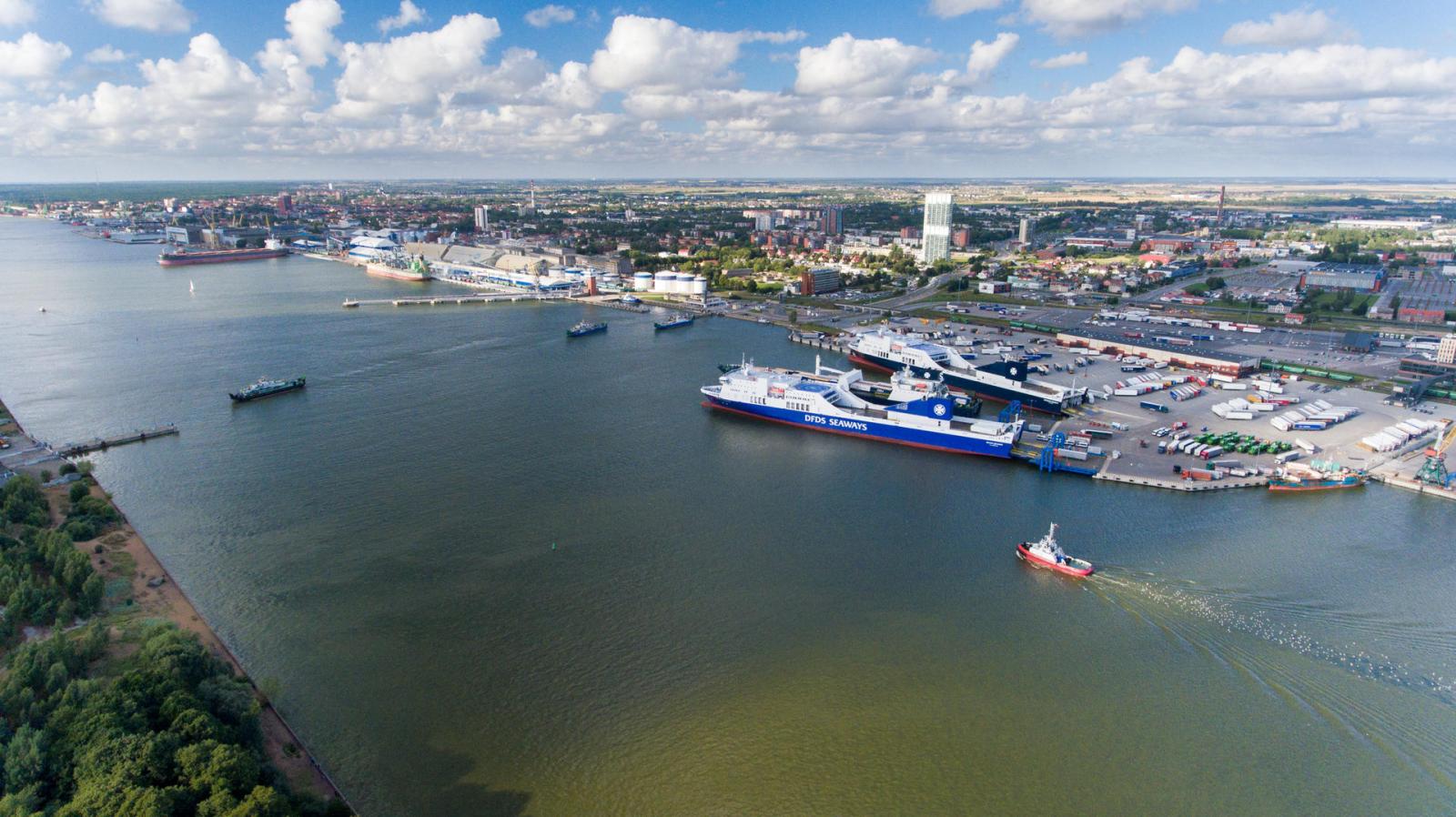 Morning in Smiltynė (0 km): The route begins at the Smiltynė ferry terminal – you will cross over to the Curonian Spit by ferry from Klaipėda. Before starting your cycling trip, refill your drinking water supply (e.g., in Klaipėda or bring full water bottles with you). Since shops and cafes on the Curonian Spit are only located in the settlements, it is advisable to have your own snacks and water for the entire day.
Morning in Smiltynė (0 km): The route begins at the Smiltynė ferry terminal – you will cross over to the Curonian Spit by ferry from Klaipėda. Before starting your cycling trip, refill your drinking water supply (e.g., in Klaipėda or bring full water bottles with you). Since shops and cafes on the Curonian Spit are only located in the settlements, it is advisable to have your own snacks and water for the entire day.
Ecological Activity: Just after leaving Smiltynė, upon reaching the first beach or forest trail, take a few minutes to collect any litter you see along the coast or in the forest (small plastic waste, paper, etc.). This is a small initiative, but the Curonian Spit National Park Administration encourages visitors to take part in such cleanups – to be intolerant of any littering and to collect any visible waste when possible. Place the collected waste in a bag and carry it with you until you reach the nearest bin in a settlement.
Note: In Smiltynė, it is worth visiting the Ethnographic Fisherman’s Homestead (an open-air museum in Kopgalis) if you want to learn more about the lives of coastal fishermen. - Cycling Route Along the Seaside: From Smiltynė to Juodkrantė, the well-maintained Seaside Bicycle Trail leads through ancient forest and dunes. This path is separated from the road and is safe even for in
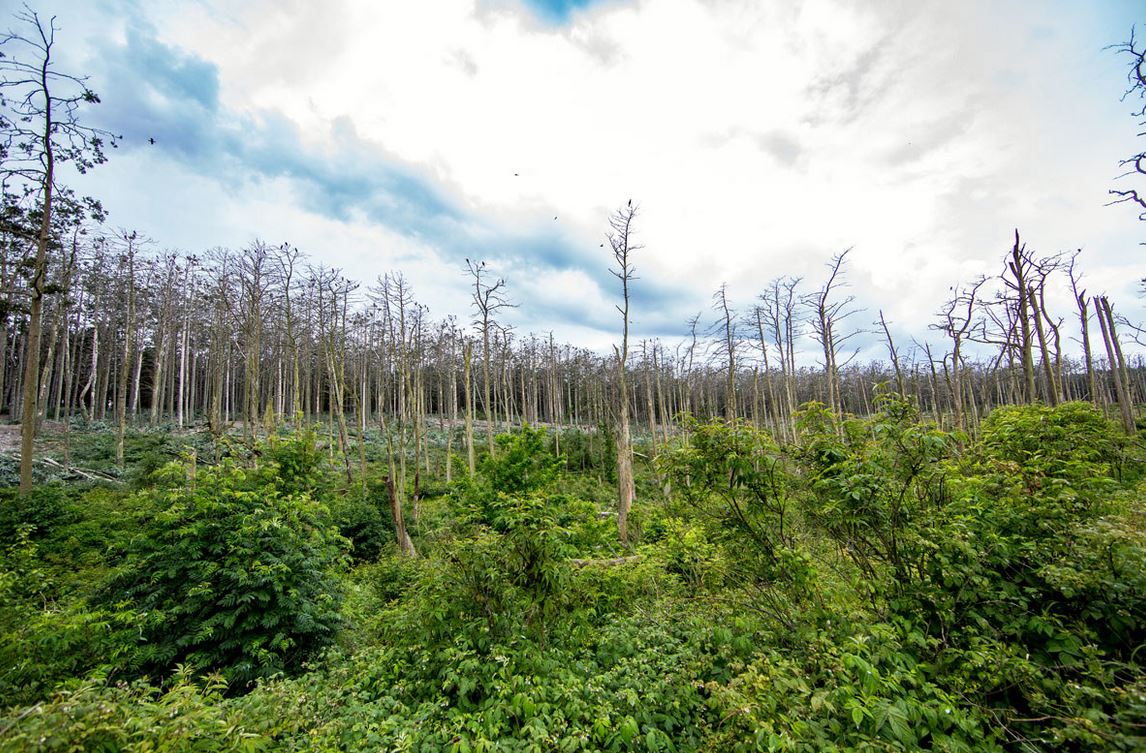 experienced cyclists – motor vehicle traffic is prohibited. As you travel along it, you can enjoy the pine forests, hear the Baltic Sea roaring from the west, and feel the calm of the Curonian Lagoon on the eastern side. About 18 km from Smiltynė, you’ll reach an information stand near the large colony of great cormorants and grey herons in Juodkrantė. This is a unique place: it is home to the largest and oldest cormorant colony in Lithuania (more than 2,000 birds nest here). From spring to mid-summer, life in this "bird city" is in full swing – hundreds of nests are built in the trees. From the designated viewing platform, you can safely observe these birds and the "ghost-like" forest area they occupy (trees dried up from bird droppings).
experienced cyclists – motor vehicle traffic is prohibited. As you travel along it, you can enjoy the pine forests, hear the Baltic Sea roaring from the west, and feel the calm of the Curonian Lagoon on the eastern side. About 18 km from Smiltynė, you’ll reach an information stand near the large colony of great cormorants and grey herons in Juodkrantė. This is a unique place: it is home to the largest and oldest cormorant colony in Lithuania (more than 2,000 birds nest here). From spring to mid-summer, life in this "bird city" is in full swing – hundreds of nests are built in the trees. From the designated viewing platform, you can safely observe these birds and the "ghost-like" forest area they occupy (trees dried up from bird droppings).
Note: Birdwatching: In addition to the cormorant colony, you can also stop at the Bulvyčiai Hill (also known as Avikalnis) observation deck near Juodkrantė – it offers a beautiful panorama of the lagoon and forests, and you may also spot waterfowl here. Eco-tip: While birdwatching, remain quiet and avoid approaching nesting areas to prevent causing stress to the birds.
- Lunch in Juodkrantė (21 km): Around noon, you will reach Juodkrantė – the second-largest settlement in the Curonian Spit. Here, we recommend having lunch at the family restaurant Žuvelė (L. Rėzos g. 1, Juodkrantė; phone: +370 607 64869), located on the shore of the lagoon. Žuvelė is known for its traditional fish dishes from the lagoon, prepared according to old fishermen’s recipes.
- Afternoon – Journey to Nida via Pervalka and Preila: After lunch, continue your journey southward on the bicycle path toward Nida. From Juodkrantė to Pervalka, it's about 16.5 km along a flat, scenic route through pine forests. Along the way, you will pass locations of several buried villages – Karvaičiai and Nagliai – marked by informational stands. Between Pervalka and Preila begins the Nagliai Nature Reserve – here starts the famous Grey (Dead) Dunes massif. If you have the strength and time, it is worth visiting the Nagliai Nature Reserve’s educational trail today (or you may leave it for tomorrow). The trail starts at the 31 km mark from Smiltynė (near Pervalka). There is a designated bicycle parking area, from which a special ~1.1 km walking trail (partly wooden, partly marked in sand) leads into the dunes. The Grey Dunes Educational Trail
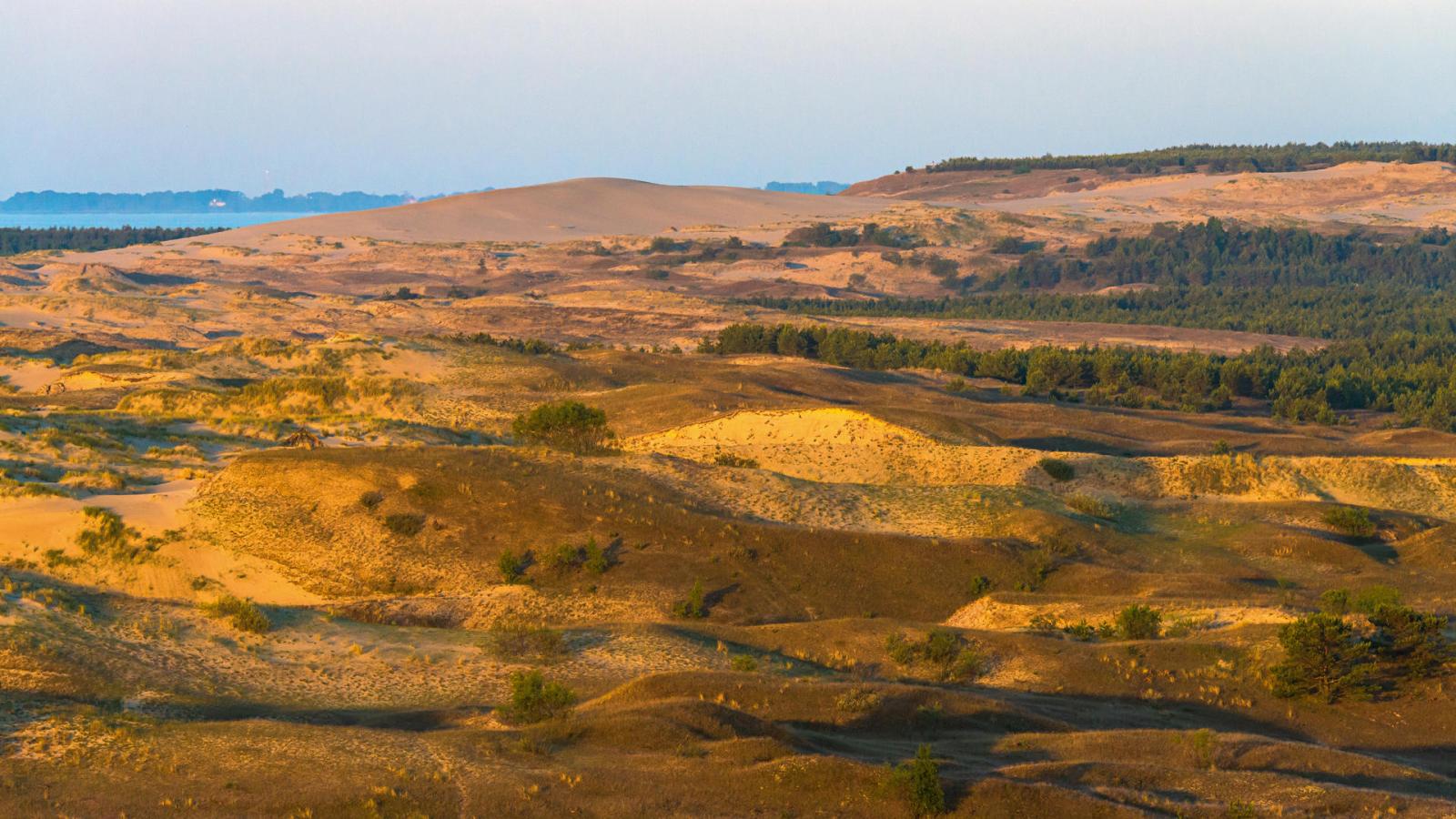 introduces you to a unique, moon-like dune landscape: here you will see 60-meter-high sand hills, called the Dead Dunes, formed by drifting sand. The trail offers views of the Great Dune Ridge, remnants of ancient buried forests, fragments of white dunes, and the bluish Curonian Lagoon on the horizon. About 200 years ago, entire villages – Nagliai, Karvaičiai – were buried under these dunes, which is why they are called "dead."
introduces you to a unique, moon-like dune landscape: here you will see 60-meter-high sand hills, called the Dead Dunes, formed by drifting sand. The trail offers views of the Great Dune Ridge, remnants of ancient buried forests, fragments of white dunes, and the bluish Curonian Lagoon on the horizon. About 200 years ago, entire villages – Nagliai, Karvaičiai – were buried under these dunes, which is why they are called "dead."
Important: The dunes are a very fragile ecosystem – scientists have calculated that each person who climbs an unauthorized slope displaces tons of sand and causes dune erosion. Therefore, strictly follow the marked paths and signs (visitors are only allowed on designated trails). During the summer season, a symbolic fee (2–5 €) is charged for visiting this trail, which goes toward the maintenance of the reserve (tickets are sold at the information post near the trail entrance).
- Continuing the journeu, you will pass through Pervalka (34 km) and Preila (38 km) – small fishing villages. In Pervalka, the Pervalka lighthouse stands on the lagoon shore (visible from land), and between Preila and Nida, you’ll find several birdwatching towers.
_r1.jpg) Birdwatching along the lagoon: From Nida to Pervalka, there are as many as six birdwatching towers installed along the Curonian Lagoon shore. They are located on scenic capes – Bulvikis Cape (near Nida), Ožkos Cape, Pervalka Cape, Žirgai Cape – as well as near Bulvikis and Karvaičiai bays. If you have time before sunset, you can stop at one of them (for example, near Preila or at Bulvikis Cape near Nida) and observe water birds. The spit is home to many species, especially during migration seasons. Bulvikis Cape near Nida is the widest part of the spit – from the observation tower, you can see Ventė Cape on the opposite shore. In these areas, you may spot swans, various ducks, sandpipers, and sometimes even sea eagles or other birds of prey.
Birdwatching along the lagoon: From Nida to Pervalka, there are as many as six birdwatching towers installed along the Curonian Lagoon shore. They are located on scenic capes – Bulvikis Cape (near Nida), Ožkos Cape, Pervalka Cape, Žirgai Cape – as well as near Bulvikis and Karvaičiai bays. If you have time before sunset, you can stop at one of them (for example, near Preila or at Bulvikis Cape near Nida) and observe water birds. The spit is home to many species, especially during migration seasons. Bulvikis Cape near Nida is the widest part of the spit – from the observation tower, you can see Ventė Cape on the opposite shore. In these areas, you may spot swans, various ducks, sandpipers, and sometimes even sea eagles or other birds of prey.
Refilling drinking water supplies: When stopping in the villages, you can refill your bottles. For example, in Nida, public drinking water fountains are installed in the central square and on the beaches, so once you arrive in Nida, you can refill your water for free – helping reduce the need for plastic bottles.
- Evening in Nida (52 km): In the late afternoon or evening, you arrive in Nida – the southernmost and largest settlement of the Curonian Spit. Overnight accommodation is planned in a traditional fisherman’s homestead. We recommend staying in an ethnographic fisherman's house on Naglių Street, in the very center of Nida, right on the lagoon shore. Once settled in, spend a calm and relaxing evening: take a walk along Nida’s seaside beach or
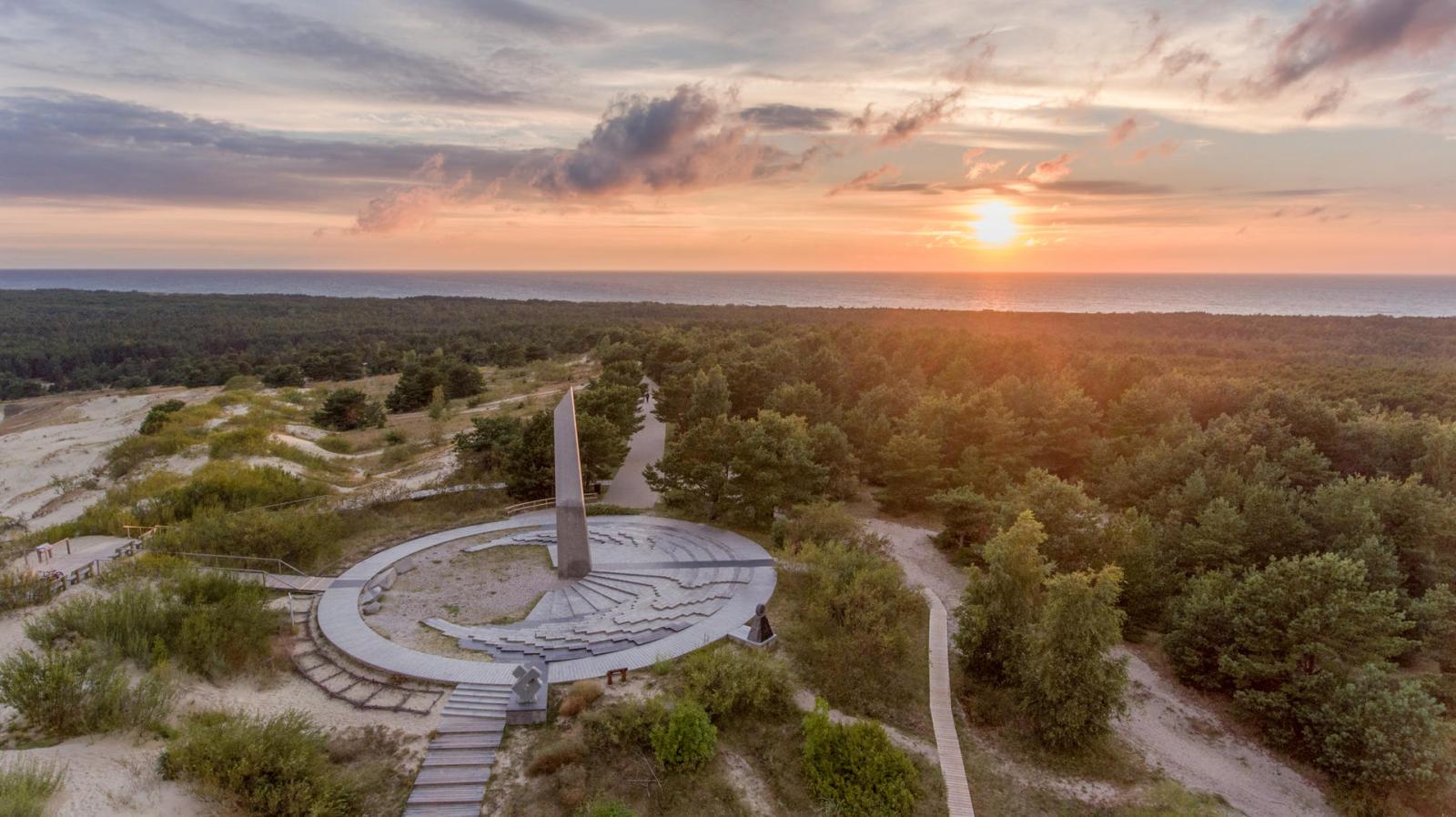 the lagoon promenade. Dinner in Nida: You can have dinner at the café Nidos Kuršis (Naglių g. 29, Nida) – a long-time local favorite known for its traditional Lithuanian and fish dishes. Here you’ll find both fresh fish meals (e.g., fried pike-perch, fish cutlets) and Lithuanian cuisine (like cepelinai, šaltibarščiai) – the menu is diverse, and the portions are generous. After dinner, take in the beauty of Nida’s nature: we recommend climbing to the Parnidis Dune observation point. The 52-meter-high Parnidis Dune is one of the tallest sand dunes in Europe, and from its summit, you’ll see a stunning panorama: in the west, the sun sets over the Baltic Sea, and in the east, it shines over the Curonian Lagoon. The famous Sun Clock is also located here – a granite sculpture-stele featuring traditional solstice symbols. At sunset, the view from Parnidis Dune is unforgettable and worth experiencing, as the Curonian Spit is the only place in Lithuania where the sun both rises and sets over water. After sunset, descend back into the town of Nida and rest for the night.
the lagoon promenade. Dinner in Nida: You can have dinner at the café Nidos Kuršis (Naglių g. 29, Nida) – a long-time local favorite known for its traditional Lithuanian and fish dishes. Here you’ll find both fresh fish meals (e.g., fried pike-perch, fish cutlets) and Lithuanian cuisine (like cepelinai, šaltibarščiai) – the menu is diverse, and the portions are generous. After dinner, take in the beauty of Nida’s nature: we recommend climbing to the Parnidis Dune observation point. The 52-meter-high Parnidis Dune is one of the tallest sand dunes in Europe, and from its summit, you’ll see a stunning panorama: in the west, the sun sets over the Baltic Sea, and in the east, it shines over the Curonian Lagoon. The famous Sun Clock is also located here – a granite sculpture-stele featuring traditional solstice symbols. At sunset, the view from Parnidis Dune is unforgettable and worth experiencing, as the Curonian Spit is the only place in Lithuania where the sun both rises and sets over water. After sunset, descend back into the town of Nida and rest for the night.
Day 2: Nida – Grey Dunes – Smiltynė (about 52 km by bicycle)
- Morning in Nida: After waking up early, you can spend some time birdwatching in Nida. Nida is an excellent place for observing birds – one of the most important bird migration routes in Northern Europe passes t
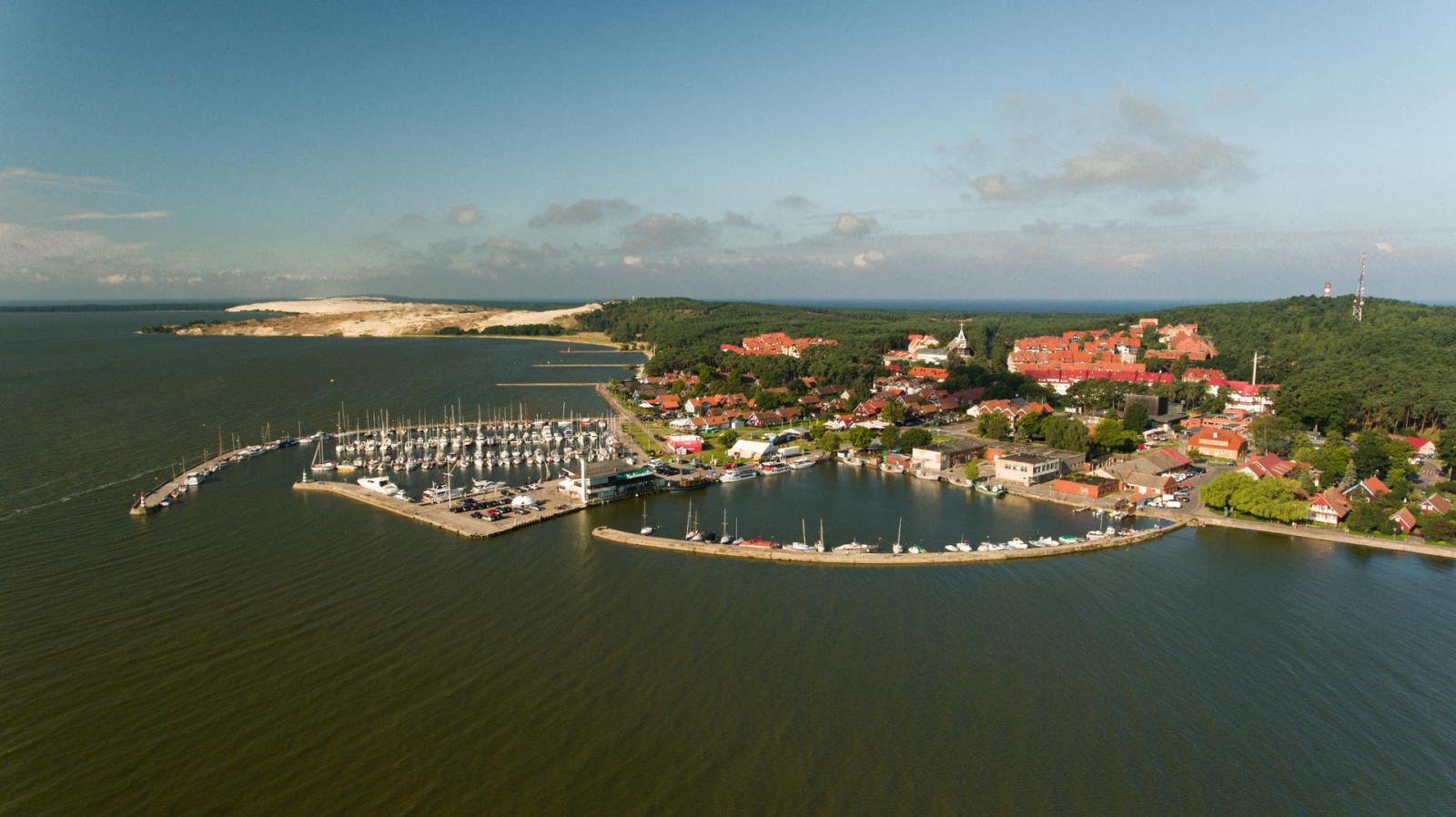 hrough the Curonian Spit. If you are a bird enthusiast, it is worth climbing the Parnidis Dune again in the early morning or walking to the sea – you’ll see various bird species, and in the morning silence, their calls are clearly audible. You can also take a short walk to the birdwatching tower at Bulvikis Cape near Nida, where in the morning, flocks of ducks, cranes, and gulls are often seen in the lagoon bay. You can have breakfast at a local bakery or café offering fresh coffee and pastries. Refill your water at the fountain in the central square and prepare some snacks for the return journey.
hrough the Curonian Spit. If you are a bird enthusiast, it is worth climbing the Parnidis Dune again in the early morning or walking to the sea – you’ll see various bird species, and in the morning silence, their calls are clearly audible. You can also take a short walk to the birdwatching tower at Bulvikis Cape near Nida, where in the morning, flocks of ducks, cranes, and gulls are often seen in the lagoon bay. You can have breakfast at a local bakery or café offering fresh coffee and pastries. Refill your water at the fountain in the central square and prepare some snacks for the return journey.
- Return Journey: The second day's route follows the same bicycle path back toward Smiltynė, but we recommend visiting places you may have missed on the first day. After leaving Nida, you will pass Preila
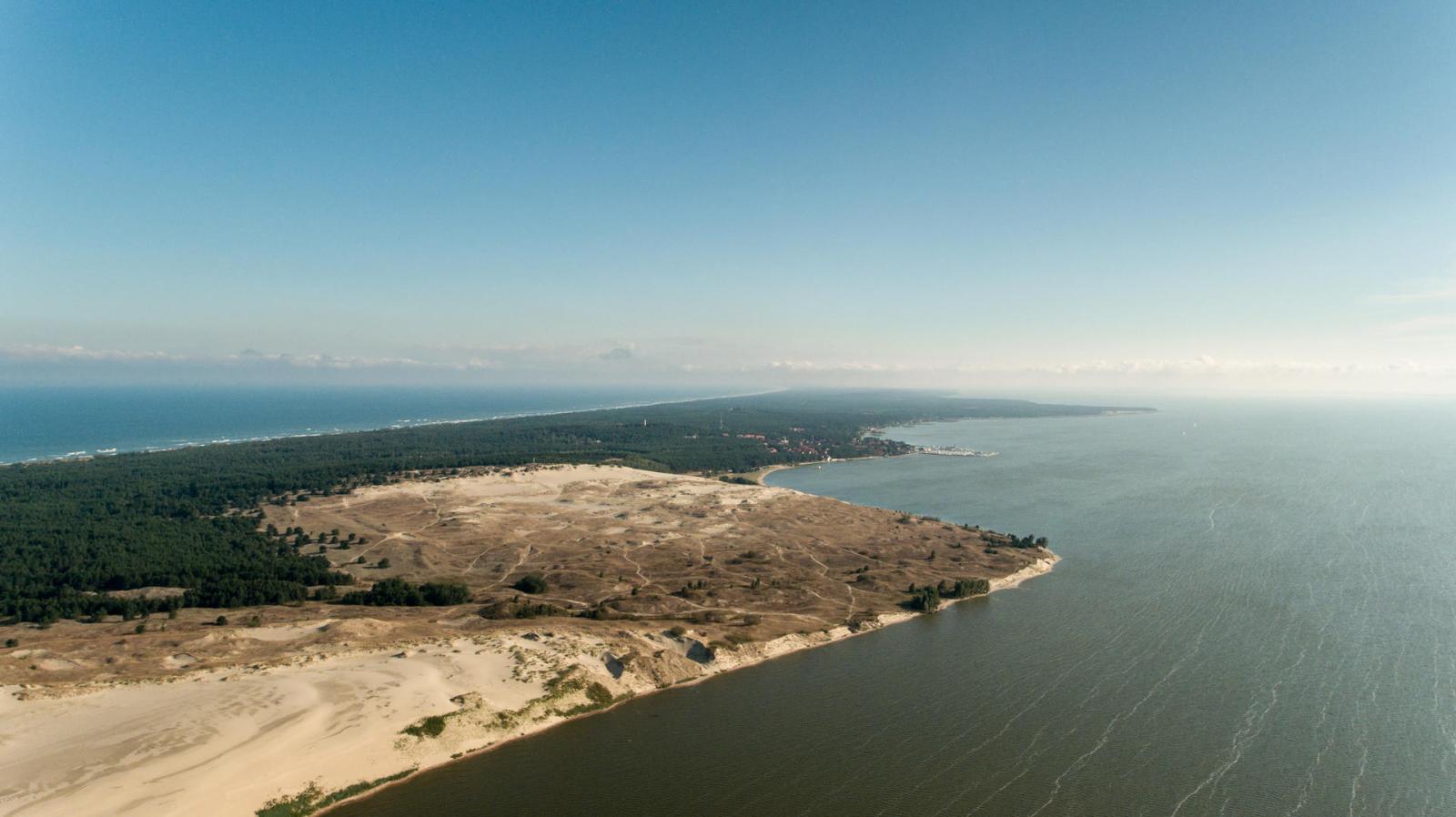 and Pervalka. Grey Dunes (Nagliai Nature Reserve): If you didn’t stop at the Nagliai educational trail yesterday or wish to experience it at a quieter time, you can stop now. In the morning, there are fewer visitors, making the dune landscape feel even more majestic in the silence. As you walk the trail, enjoy once again the unique beauty of the Grey Dunes, remembering that entire villages lie buried beneath the sand under your feet. Please remember to stay on the wooden trail – do not walk on the open sand outside the marked path, as it damages the dunes. From the top of the dunes, in daylight, you may even see the towers of Klaipėda city in the distance to the north. The trail takes about 1 hour to complete. Continue your bike ride onward.
and Pervalka. Grey Dunes (Nagliai Nature Reserve): If you didn’t stop at the Nagliai educational trail yesterday or wish to experience it at a quieter time, you can stop now. In the morning, there are fewer visitors, making the dune landscape feel even more majestic in the silence. As you walk the trail, enjoy once again the unique beauty of the Grey Dunes, remembering that entire villages lie buried beneath the sand under your feet. Please remember to stay on the wooden trail – do not walk on the open sand outside the marked path, as it damages the dunes. From the top of the dunes, in daylight, you may even see the towers of Klaipėda city in the distance to the north. The trail takes about 1 hour to complete. Continue your bike ride onward.
- Afternoon in Juodkrantė: On your way back through Juodkrantė, you can stop here for lunch or a short rest. If you didn’t visit the Hill of Witches sculpture trail on the first day (a wooden sculpture park in the pi
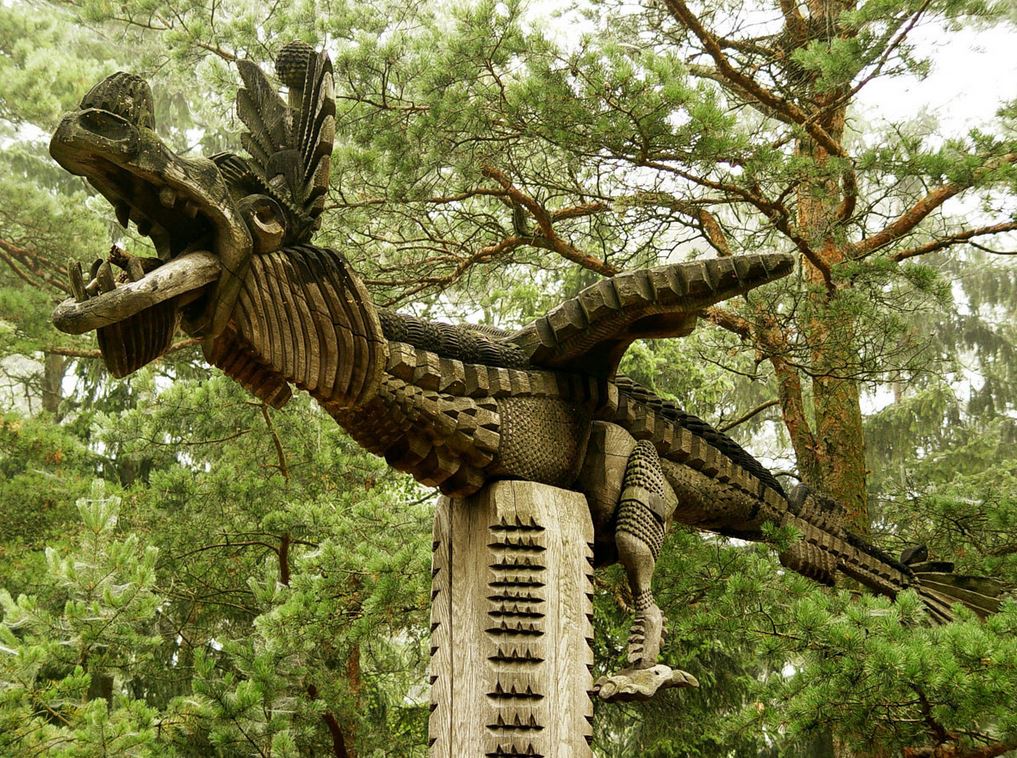 ne forest), you can do so now – the ~1 km forest trail with carved devils and witches offers a nice break from cycling. It is the only site on this route with a cultural focus, but it blends into the natural surroundings (you can walk the trail in about 30 minutes). Lunch in Juodkrantė: If you’re hungry, you can have lunch in Juodkrantė. Besides the already mentioned Žuvelė, there are other cafes – for example, the restaurant Juodasis kalnas (Ievos Kalno g. 22) or the café Pamario takas. Choose a place where you can try local dishes – perhaps freshly smoked eel (often sold at the pier) or a traditional fish pie. Don’t forget to act sustainably here as well: avoid plastic straws, and sort your food waste (many cafes already have separate containers).
ne forest), you can do so now – the ~1 km forest trail with carved devils and witches offers a nice break from cycling. It is the only site on this route with a cultural focus, but it blends into the natural surroundings (you can walk the trail in about 30 minutes). Lunch in Juodkrantė: If you’re hungry, you can have lunch in Juodkrantė. Besides the already mentioned Žuvelė, there are other cafes – for example, the restaurant Juodasis kalnas (Ievos Kalno g. 22) or the café Pamario takas. Choose a place where you can try local dishes – perhaps freshly smoked eel (often sold at the pier) or a traditional fish pie. Don’t forget to act sustainably here as well: avoid plastic straws, and sort your food waste (many cafes already have separate containers).
Waste Sorting: The Neringa municipality strongly encourages visitors to sort their waste – containers for plastic, paper, and glass are placed all over the spit. In 2023, more than 87 tons of packaging waste were collected in Neringa, over half of it during the summer months. So do your part too: dispose of your waste (e.g., water bottles, food packaging) in the appropriate recycling containers, which can be found in central locations or near the bus stop in Juodkrantė.
- Afternoon Continued – Smiltynė: With ~20 km remaining to your final destination, continue cycling north from Juodkrantė on the bike path. This section runs through the forest near the sea, so if you wish, y
 ou can make a short stop at the beach – to cool down, swim (if it’s the season), or simply relax by the shore. Reminder: At the beach, follow eco-friendly principles – do not leave litter, avoid smoking in protected areas, and don’t disturb birds. You will reach Smiltynė in the second half of the day (around evening). At the end of the route, before taking the ferry back to Klaipėda, you can visit Smiltynė beach or the nearby forest educational trail, if you still have energy – there are several informational stands about the coastal forest ecosystem.
ou can make a short stop at the beach – to cool down, swim (if it’s the season), or simply relax by the shore. Reminder: At the beach, follow eco-friendly principles – do not leave litter, avoid smoking in protected areas, and don’t disturb birds. You will reach Smiltynė in the second half of the day (around evening). At the end of the route, before taking the ferry back to Klaipėda, you can visit Smiltynė beach or the nearby forest educational trail, if you still have energy – there are several informational stands about the coastal forest ecosystem.
- End of the Journey: Return to the Smiltynė ferry terminal and take the ferry back to Klaipėda. Once you’re back in Klaipėda, you can be proud of having visited the natural gems of the Curonian Spit without using a car and leaving only a minimal environmental footprint.
- Alternative: If you feel tired in the morning and don’t want to cycle the full 52 km back, you can choose an alternative return option – the Benas ship (Nida–Klaipėda), which operates in the summer and allows bicycles on board.
Service Providers Along the Route:
- Smiltynė Ferry (Klaipėda–Smiltynė ferry): Ferries run frequently; timetables are available on the company’s website. Ticket prices for pedestrians and cyclists are just a few euros (bicycles are transported free of charge or for a symbolic fee).
- Fish Restaurant “Žuvelė” (Juodkrantė): L. Rėzos g. 1-2, Juodkrantė. Phone +370 607 64869. Offers traditional fish dishes from the Curonian Lagoon region (fish soup, eel, etc.). Open during the season, Friday–Sunday ~12:00–20:00.
- Café “Nidos Kuršis” (Nida): Naglių g. 29, Nida. Phine +370 469 52345. Traditional cuisine, fish dishes. Open year-round.
- Tourist Information Center (Nida Culture and Tourism Information Center “Agila”): Taikos g. 4, Nida. Phone +370 469 52345. Here you can get free maps, information about public water refill stations and waste sorting container locations, as well as details on organized clean-up events or guide services. For inquiries related to the National Park Directorate: Phone +370 469 51224.
- Accommodation in Nida: Nida offers several cozy homesteads, as well as many apartments and hotels. For the most unique experience, we recommend staying in countryside tourism homesteads or villas on the lagoon shore. These should be booked in advance, especially on summer weekends. Here are a few options:
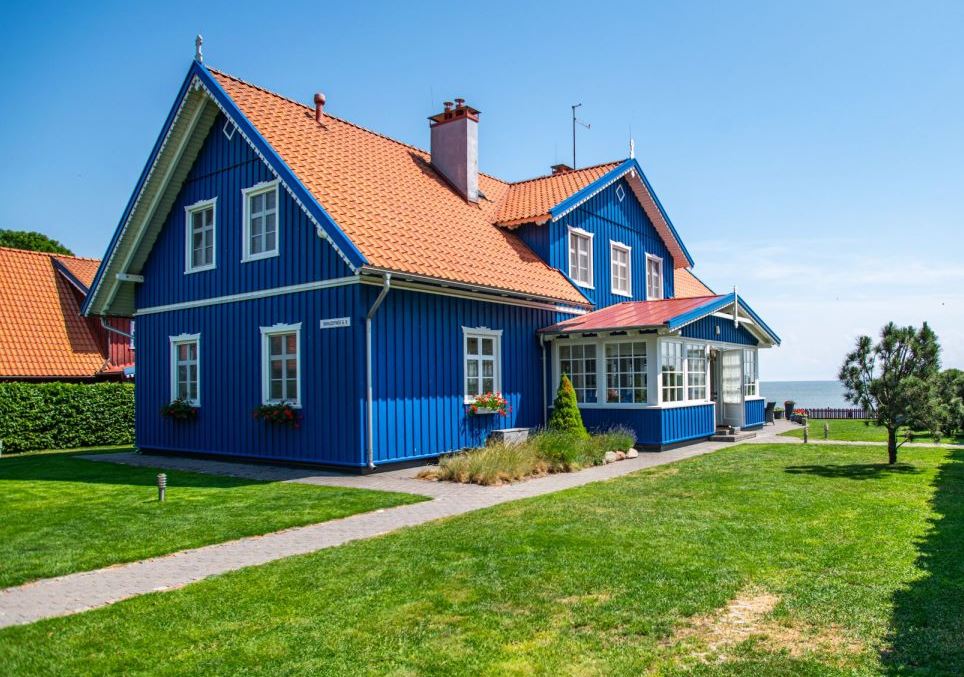 Apartaments „Mėlyna Vila“:
Apartaments „Mėlyna Vila“:- Skruzdynės st. 8, Nida
- Phone: +370 698 35835
Rooms in Ethnographic Fisherman’s Homestead:
- Naglių st. 9-2, Nida
- Phone: +370 605 92770
Tips: All visited places on the route are natural, so follow the park rules: don’t stray off marked trails, don’t damage dune vegetation, don’t light fires in unauthorized areas. Respect wildlife — do not approach wild an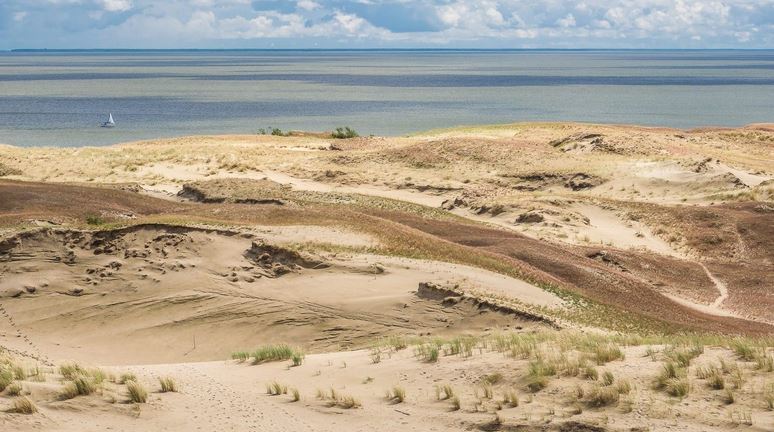 imals, keep dogs on a leash. Save water and energy — e.g., turn off unnecessary lights and use showers responsibly in accommodations. The Curonian Spit National Park is a UNESCO protected area, a unique creation of nature and humans. Your chosen ecotourism route helps preserve this area. Your two-day journey has come to an end, but the impressions — the dune landscapes, the abundance of birds you encountered, the delicious fish dishes, and the good work you did collecting litter — will stay in your memory for a long time. We wish that the inspiration of the Curonian Spit remains with you and encourages you to continue traveling responsibly!
imals, keep dogs on a leash. Save water and energy — e.g., turn off unnecessary lights and use showers responsibly in accommodations. The Curonian Spit National Park is a UNESCO protected area, a unique creation of nature and humans. Your chosen ecotourism route helps preserve this area. Your two-day journey has come to an end, but the impressions — the dune landscapes, the abundance of birds you encountered, the delicious fish dishes, and the good work you did collecting litter — will stay in your memory for a long time. We wish that the inspiration of the Curonian Spit remains with you and encourages you to continue traveling responsibly!
Full route in PDF format.
This project is implemented with the financial support from the BESTbelt project of the European Union. The contents of this project are the sole responsibility of Lithuanian countryside tourism association and can under no circumstances be regarded as reflecting the position of the European Union.

 Morning in Smiltynė (0 km): The route begins at the Smiltynė ferry terminal – you will cross over to the Curonian Spit by ferry from Klaipėda. Before starting your cycling trip, refill your drinking water supply (e.g., in Klaipėda or bring full water bottles with you). Since shops and cafes on the Curonian Spit are only located in the settlements, it is advisable to have your own snacks and water for the entire day.
Morning in Smiltynė (0 km): The route begins at the Smiltynė ferry terminal – you will cross over to the Curonian Spit by ferry from Klaipėda. Before starting your cycling trip, refill your drinking water supply (e.g., in Klaipėda or bring full water bottles with you). Since shops and cafes on the Curonian Spit are only located in the settlements, it is advisable to have your own snacks and water for the entire day. introduces you to a unique, moon-like dune landscape: here you will see 60-meter-high sand hills, called the Dead Dunes, formed by drifting sand. The trail offers views of the Great Dune Ridge, remnants of ancient buried forests, fragments of white dunes, and the bluish Curonian Lagoon on the horizon. About 200 years ago, entire villages – Nagliai, Karvaičiai – were buried under these dunes, which is why they are called "dead."
introduces you to a unique, moon-like dune landscape: here you will see 60-meter-high sand hills, called the Dead Dunes, formed by drifting sand. The trail offers views of the Great Dune Ridge, remnants of ancient buried forests, fragments of white dunes, and the bluish Curonian Lagoon on the horizon. About 200 years ago, entire villages – Nagliai, Karvaičiai – were buried under these dunes, which is why they are called "dead."_r1.jpg) Birdwatching along the lagoon: From Nida to Pervalka, there are as many as six birdwatching towers installed along the Curonian Lagoon shore. They are located on scenic capes – Bulvikis Cape (near Nida), Ožkos Cape, Pervalka Cape, Žirgai Cape – as well as near Bulvikis and Karvaičiai bays. If you have time before sunset, you can stop at one of them (for example, near Preila or at Bulvikis Cape near Nida) and observe water birds. The spit is home to many species, especially during migration seasons. Bulvikis Cape near Nida is the widest part of the spit – from the observation tower, you can see Ventė Cape on the opposite shore. In these areas, you may spot swans, various ducks, sandpipers, and sometimes even sea eagles or other birds of prey.
Birdwatching along the lagoon: From Nida to Pervalka, there are as many as six birdwatching towers installed along the Curonian Lagoon shore. They are located on scenic capes – Bulvikis Cape (near Nida), Ožkos Cape, Pervalka Cape, Žirgai Cape – as well as near Bulvikis and Karvaičiai bays. If you have time before sunset, you can stop at one of them (for example, near Preila or at Bulvikis Cape near Nida) and observe water birds. The spit is home to many species, especially during migration seasons. Bulvikis Cape near Nida is the widest part of the spit – from the observation tower, you can see Ventė Cape on the opposite shore. In these areas, you may spot swans, various ducks, sandpipers, and sometimes even sea eagles or other birds of prey.  the lagoon promenade. Dinner in Nida: You can have dinner at the café Nidos Kuršis (Naglių g. 29, Nida) – a long-time local favorite known for its traditional Lithuanian and fish dishes. Here you’ll find both fresh fish meals (e.g., fried pike-perch, fish cutlets) and Lithuanian cuisine (like cepelinai, šaltibarščiai) – the menu is diverse, and the portions are generous. After dinner, take in the beauty of Nida’s nature: we recommend climbing to the Parnidis Dune observation point. The 52-meter-high Parnidis Dune is one of the tallest sand dunes in Europe, and from its summit, you’ll see a stunning panorama: in the west, the sun sets over the Baltic Sea, and in the east, it shines over the Curonian Lagoon. The famous Sun Clock is also located here – a granite sculpture-stele featuring traditional solstice symbols. At sunset, the view from Parnidis Dune is unforgettable and worth experiencing, as the Curonian Spit is the only place in Lithuania where the sun both rises and sets over water. After sunset, descend back into the town of Nida and rest for the night.
the lagoon promenade. Dinner in Nida: You can have dinner at the café Nidos Kuršis (Naglių g. 29, Nida) – a long-time local favorite known for its traditional Lithuanian and fish dishes. Here you’ll find both fresh fish meals (e.g., fried pike-perch, fish cutlets) and Lithuanian cuisine (like cepelinai, šaltibarščiai) – the menu is diverse, and the portions are generous. After dinner, take in the beauty of Nida’s nature: we recommend climbing to the Parnidis Dune observation point. The 52-meter-high Parnidis Dune is one of the tallest sand dunes in Europe, and from its summit, you’ll see a stunning panorama: in the west, the sun sets over the Baltic Sea, and in the east, it shines over the Curonian Lagoon. The famous Sun Clock is also located here – a granite sculpture-stele featuring traditional solstice symbols. At sunset, the view from Parnidis Dune is unforgettable and worth experiencing, as the Curonian Spit is the only place in Lithuania where the sun both rises and sets over water. After sunset, descend back into the town of Nida and rest for the night. hrough the Curonian Spit. If you are a bird enthusiast, it is worth climbing the Parnidis Dune again in the early morning or walking to the sea – you’ll see various bird species, and in the morning silence, their calls are clearly audible. You can also take a short walk to the birdwatching tower at Bulvikis Cape near Nida, where in the morning, flocks of ducks, cranes, and gulls are often seen in the lagoon bay. You can have breakfast at a local bakery or café offering fresh coffee and pastries. Refill your water at the fountain in the central square and prepare some snacks for the return journey.
hrough the Curonian Spit. If you are a bird enthusiast, it is worth climbing the Parnidis Dune again in the early morning or walking to the sea – you’ll see various bird species, and in the morning silence, their calls are clearly audible. You can also take a short walk to the birdwatching tower at Bulvikis Cape near Nida, where in the morning, flocks of ducks, cranes, and gulls are often seen in the lagoon bay. You can have breakfast at a local bakery or café offering fresh coffee and pastries. Refill your water at the fountain in the central square and prepare some snacks for the return journey. and Pervalka. Grey Dunes (Nagliai Nature Reserve): If you didn’t stop at the Nagliai educational trail yesterday or wish to experience it at a quieter time, you can stop now. In the morning, there are fewer visitors, making the dune landscape feel even more majestic in the silence. As you walk the trail, enjoy once again the unique beauty of the Grey Dunes, remembering that entire villages lie buried beneath the sand under your feet. Please remember to stay on the wooden trail – do not walk on the open sand outside the marked path, as it damages the dunes. From the top of the dunes, in daylight, you may even see the towers of Klaipėda city in the distance to the north. The trail takes about 1 hour to complete. Continue your bike ride onward.
and Pervalka. Grey Dunes (Nagliai Nature Reserve): If you didn’t stop at the Nagliai educational trail yesterday or wish to experience it at a quieter time, you can stop now. In the morning, there are fewer visitors, making the dune landscape feel even more majestic in the silence. As you walk the trail, enjoy once again the unique beauty of the Grey Dunes, remembering that entire villages lie buried beneath the sand under your feet. Please remember to stay on the wooden trail – do not walk on the open sand outside the marked path, as it damages the dunes. From the top of the dunes, in daylight, you may even see the towers of Klaipėda city in the distance to the north. The trail takes about 1 hour to complete. Continue your bike ride onward.imals, keep dogs on a leash. Save water and energy — e.g., turn off unnecessary lights and use showers responsibly in accommodations. The Curonian Spit National Park is a UNESCO protected area, a unique creation of nature and humans. Your chosen ecotourism route helps preserve this area. Your two-day journey has come to an end, but the impressions — the dune landscapes, the abundance of birds you encountered, the delicious fish dishes, and the good work you did collecting litter — will stay in your memory for a long time. We wish that the inspiration of the Curonian Spit remains with you and encourages you to continue traveling responsibly!
